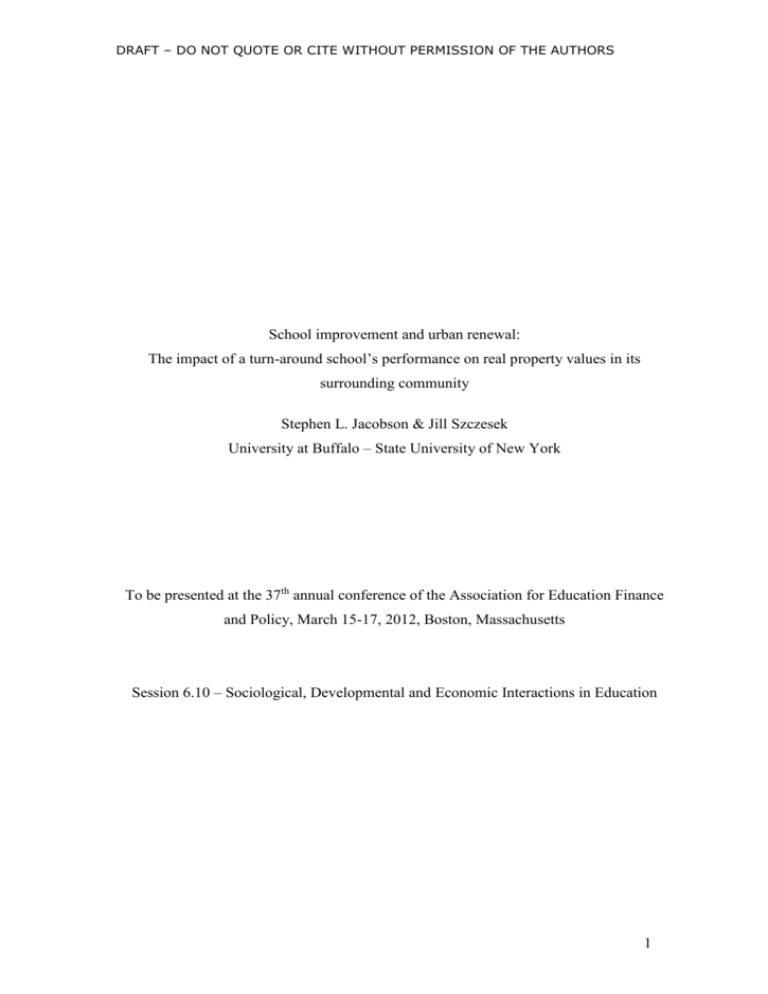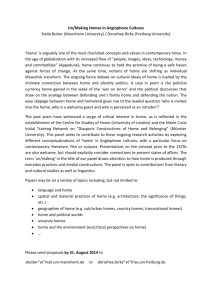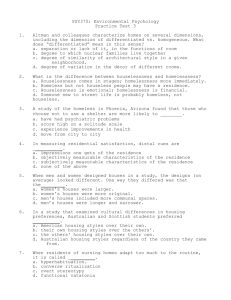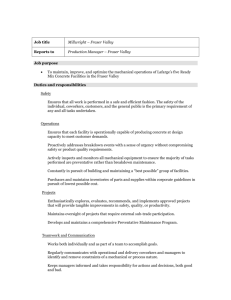National Contexts
advertisement

DRAFT – DO NOT QUOTE OR CITE WITHOUT PERMISSION OF THE AUTHORS School improvement and urban renewal: The impact of a turn-around school’s performance on real property values in its surrounding community Stephen L. Jacobson & Jill Szczesek University at Buffalo – State University of New York To be presented at the 37th annual conference of the Association for Education Finance and Policy, March 15-17, 2012, Boston, Massachusetts Session 6.10 – Sociological, Developmental and Economic Interactions in Education 1 DRAFT – DO NOT QUOTE OR CITE WITHOUT PERMISSION OF THE AUTHORS School improvement and urban renewal: The impact of a turn-around school’s performance on real property values in its surrounding community Stephen L. Jacobson & Jill Szczesek University at Buffalo – State University of New York Abstract This study investigates the economic impact of a ‘turn-around’ school on real property values in its surrounding community. What began as anecdotal information from interviews first conducted in 2001 during the initial phase of a study on successful leadership in a high poverty, high need school, led to the current investigation, which examined the community’s property rolls. Using single-family home sales found on the Multiple Listing System in the region and data from the region’s Realist Tax Record database, we examined property ownership and financing and found that property values in the school’s enrollment catchment area were higher than in comparable, nearby neighborhoods that fed other public schools. Moreover, the houses in the school’s community were selling much closer to the initial asking price and were on the market for a shorter time, on average, than in comparable neighborhoods. Introduction and overview This study further investigates the effects of school improvement on community renewal as initially reported by Jacobson, Johnson, Ylimaki & Giles, (2009)1, in “Sustaining school success: A case for governance change”. Specifically, in this paper we report the economic impacts of a ‘turn-around’ school on real property values in the school’s surrounding community. What began as anecdotal information first obtained during interviews conducted in 2001 as part of the first phase of a study on successful leadership in a high poverty, high need school, led to the current investigation focused on finding supportive empirical evidence. In those initial interviews, teachers and parents from the school told us that as the school’s reputation improved, there were parents who had begun buying homes in the surrounding neighborhood so that their children would have access to the school. We found preliminary support for this claim in the 2000 U.S. census data, which revealed that the community was one of only three neighborhoods in the entire school system that had experienced an in-migration of African Americans subsequent to the 1990 census, and the only one of the three being primarily families with children. This demographic movement is significant because it began after the school’s turn-around, which itself had started shortly after the school entered into a partnership with a regional bank and had appointed a new principal in 1994. 1 Further detail about the school’s academic ‘turn-around’ can be found in Giles, Johnson, Brooks & Jacobson (2005) and Jacobson, Brooks, Giles, Johnson & Ylimaki (2007). 2 DRAFT – DO NOT QUOTE OR CITE WITHOUT PERMISSION OF THE AUTHORS The school and its community Fraser Academy (a pseudonym), is a K-8 public school in New York State’s second largest district, which is also the most heavily state subsidized as a percentage of revenues. At the time of the partnership with the bank in 1994, Fraser was considered to be the poorest performing school in the entire district, a district with a reputation for under-performing schools. The bank sought to develop the partnership in compliance with the Housing and Community Development Act of 1977/Title VIII2. More commonly known as the Community Reinvestment Act of 1977, this law requires that financial institutions demonstrate they serve the convenience and needs of the communities in which they are chartered to do business. Such compliance becomes especially important when banks are considering mergers, consolidations and/or acquisitions of other financial institutions, i.e., expansions of the type the bank in question was embarking upon. Between 1990 and 2000, the city in which Fraser is situated experienced a decline in population, an increase in unemployment and a lowering of its median household income. Yet, inconsistent with these conditions of the time period, a bit of anecdotal information gleaned from the initial interviews was the claim that subsequent to the school’s partnership with the bank, some parents had actually paid more than the seller’s original asking price for houses located in Fraser’s enrollment neighborhood. The occurrence of home sale prices exceeding asking price is not unusual in more affluent communities where potential homeowners may bid up the price as they compete for access for their children to schools held in high regard. But in a low-income neighborhood, such as the one surrounding Fraser, the phenomenon is atypical; therefore we needed to examine local property rolls to see if there was any empirical support for this claim. The community surrounding Fraser would best be described as ‘inner-city’, i.e., a residential, but deteriorating urban environment with mixed-use properties including single family and multi-family unit homes, housing predominately low income, African American families. The community also has a few commercial properties with retail businesses and small manufacturing sites. Physically, the neighborhood within walking vicinity of the school resembles many other such ‘inner-city’ neighborhoods in the same municipality, with neglected and abandoned properties, often having graffiti covered walls. Subsequent to the bank partnership and the principal’s arrival, Fraser experienced a remarkable turnaround in student performance as evidenced by New York State Education Department (NYSED) school report card data (Jacobson et al. 2007). In fact, Fraser had gone from being one of the worst to one of the best schools in the district. Comparing the percent of students achieving mastery at Fraser with the district average in 1998-99, 2002-03, and 2007-08, Fraser exceeds the district average in 20 out of 21 comparisons, over 95% of the time (Table 1). In 1993-94, the year prior to the partnership, Fraser exceeded the district in only 20% (2 out of 10) of comparable comparisons. Moreover, the average difference in the percent of mastery learning at 2 For more details about the Community Reinvestment Act go to : http://www.federalreserve.gov/communitydev/cra_about.htm 3 DRAFT – DO NOT QUOTE OR CITE WITHOUT PERMISSION OF THE AUTHORS Fraser, as compared to the district, grew from 12.6% in 1998-99 to 29.4% in 2002-03, dipping just slightly to 27.8% in 2007-08 (more recent data is currently being examined). In other words, Fraser managed to sustain very laudable student achievement scores, when compared to the rest of the district, even in the face of the district’s budget crisis. Grade 4 ELA 1998-1999 2002-2003 2007-2008 FCCS 26 56 59 District 29 34 42 Grade 4 Math 1998-1999 2002-2003 2007-2008 FCCS 60 95 72 District 54 58 53 Grade 4 Science 1999-2000 2002-2003 2007-2008 FCCS 76 84 79 District 47 51 63 Grade 5 Social Studies 2002-2003 2007-2008 FCCS 92 79 District 50 53 Grade 8 ELA 1998-1999 2002-2003 2007-2008 FCCS 41 30 66 District 31 22 28 Grade 8 Math 1998-1999 2002-2003 2007-2008 FCCS 43 70 77 District 22 32 34 Grade 8 Science (Regents) 2002-2003 2007-2008 FCCS 96 80 District 65 50 Grade 8 Social Studies 2002-2003 2007-2008 FCCS 66 64 District 40 31 29.4 27.8 AVE. (%) Diff. 12.6 In 2004, Fraser Academy became a conversion charter school – Fraser Community Charter School (FCCS) – in order to stave off some of the human resource problems created by the district’s budget crisis3. The key point is that by becoming a conversion charter school, FCCS remained in the same building under the jurisdiction of the district, Detail about the district crisis and the school’s response can be found in Jacobson et al. 2009 3 4 DRAFT – DO NOT QUOTE OR CITE WITHOUT PERMISSION OF THE AUTHORS but with greater fiscal and human resource autonomy4. FCCS was able to keep those teachers who wanted to stay, as well as all of its neighborhood students. The transition to charter school required a majority of parental support and the election that was authorized produced a parent turnout of over 80%, with almost 100% voting for conversion; another measure of the support the school had from its parents. Although the lottery system it now employs for enrollment allows students to enter FCCS even if they live outside of the old enrollment catchment area, over 90% of the school’s student population still live within the old boundaries, in part because the school gives priority to siblings of students who are currently in, or who have graduated from Fraser, which extends the benefit initially sought by their parents. It is also important to note that subsequent to the bank partnership there have been improvements to the school facility itself and its surrounding grounds, including the annexation and renovation of an abandoned branch of the county library, the addition of an early child care facility and community health center, a renovated park with a basketball court and a play space for FCCS students during school hours and neighborhood youth afterwards. As a result, FCCS has become the centerpiece of the neighborhood having established a more positive presence in the community. Research methods For the purpose of this study, we examined property value indicators in the Fraser Academy enrolment catchment and in a neighboring area using data collected for real estate transactions recorded between 2001 to mid-2011. We restricted our analysis to single-family homes, the predominant style of housing in the area. For each property sold during those 10 years, we recorded list price, sale price, number of days on the market, and sale price per square foot. A total of 247 homes met our criteria and then the aggregated sales data in the two areas were analyzed and compared. Sales were defined as homes that had been listed on the market through the Multiple Listing System in the region and had resulted in a real estate closing. Data for homes that had been sold by the owner, independent of a real estate office were not included as this data was inaccessible. Data was also collected from the region’s Realist Tax Record database. These records were examined for qualitative information pertaining to property ownership and financing. We compared the data for sales in two groups: those within the Fraser catchment area (n = 167), and those in a comparable neighbourhood just outside of it (n = 80), along three key measures: (1) the number of days a house was on the market; (2) the list to sale price ratio (LSPR); and (3) the sales price per square foot (PSF). These indicators can often fluctuate from one neighborhood to the next in the same municipality as supply and demand influence each other. Homes in greater demand will typically spend fewer days on the market; have a higher LSPR, since owner’s can hold out for a more desirable price as a result of the increased interest; and they will often have a higher PSF, a further indicator of demand and perceived home desirability. Findings Details about NY’s Charter Schools Act can be found at: http://www.nycsa.org/Legislation/CSLaws/CS%20law.pdf). 4 5 DRAFT – DO NOT QUOTE OR CITE WITHOUT PERMISSION OF THE AUTHORS Before reviewing our findings, it is important we place the neighborhoods we are examining into their municipal context, as well as the housing market context for the period being studied. Fraser Academy is situated in a region who’s housing market is an anomaly compared to other mid-sized markets in the United States. Prices in the community neither ‘boomed’ nor ‘busted’ with the national housing fluctuations from 2002 till 2008. Immunity from these volatile conditions established a market that is stable within its own confines, but one that is not oblivious, nor impervious to the conditions beyond it. Leading up till 2008 the Fraser market did experience an increase in unit sales (BNAR, 2011), consistent with high home sales activity across the country. However, pertaining to home values, the Fraser community has been less subject to the artificially increased property values that other communities have seen. With the community’s property tax burden being in the top 10% in the country (Forbes, 2009), a significant increase in sales price and ‘value’ would, in many respects, have been impossible with the tax burden on its homeowners. Higher sale prices correlate to increased property taxes and the market is at a tax threshold that, if increased, would potentially prohibit home ownership. Following the onset of the housing crisis in 2008, the local market did see a ripple effect evidenced in declines in annual unit sales and stagnancy in home sales in the top 10% of sale prices in the region. Median sale price for a single family home in the area in 2010 was $110,000 (BNAR, 2010). Homes well above this threshold have seen delayed sales with evidence that the average time from list to sale for a home equivalent to the median is 51 days (NYS Mlxchange, 2011), but homes above this price take an average of a month longer to sell at 76 days. As well, there has been and increased demand for rental properties as conditions for mortgage credit become more constrained. Homes on the market in the Fraser community that are reflective of, or below, the region’s average sales price have been impacted as well by the national crisis, but ever so minimally. Average LSPR, an indicator of stability in a market, has been stable even as the national market was in a tumultuous position. These homes during the upswing of the housing market were appreciating in value in a range of 3-5% per year (Buffalo Niagara Association of Realtors, 2010); in 2010 they maintained value without appreciation, yet many other cities across the country were still seeing declining values. The neighborhoods surrounding the ‘Fraser’ school when compared to average home values in its local market would be lower than the mean, and this category as well has not seen decline in value. With those factors in mind, our data reveal that home sales in the school’s catchment neighborhood, which are all within walking distance of the school, differ from sales on streets nearby but not within the school’s neighborhood. For example, the number of days a home stays on the market for sale is an indicator of demand, or lack thereof. The number of days it takes to sell a property is fixed. From its initial listing, real estate records will count the number of days it takes to achieve a valid and executable offer. We found that the median number of days a home stayed on the market on streets surrounding the school was less than half that of homes on streets beyond the school’s boundaries, 58 as compared to 129 days (See Figure 1). It is also notable 6 DRAFT – DO NOT QUOTE OR CITE WITHOUT PERMISSION OF THE AUTHORS that the Fraser catchment area had some homes selling the same day they were listed, another indicator of high demand. The higher frequency of closed transactions in our data set for the Fraser streets is also indicative of a higher demand for the homes in that area. Home values in Fraser’s neighborhood also differ from those on similar streets outside the school boundary. Again, the two indicators we used to establish property value were: (1) a list to sale price ratio (LSPR), and (2) the sale price per square foot (PSF). LSPR can be adjusted for a property by lowering sales price periodically until a property finds enough activity to generate a sale at an appropriate list price. A two bedroom home in the Fraser market would probably see little activity if listed at $500,000, but if priced at $50,000 might sell for 100% of the listing price. Streets in the school’s catchment neighborhood reveal numerous cases of homes selling for 100% of the list to sale price; a ratio more comparable to conditions in the marketplace for homes outside of the ‘innercity’ for that the same time period. In contrast, similar one-family homes on district streets outside the catchment of the school reveal a far lower LSPR. On average, Fraser properties were selling for 93.14% of the asking price as compared to only 73.55% in bordering comparable properties (See Table 2). Although less indicative of demand and more closely related to the value of a home is sale price per square foot (PSF). The cost of new construction PSF fluctuates annually and is influenced by many factors including labor costs, cost of materials, and the size of a home to be constructed. Existing homes do not see variances as a result of these factors, but will differ based on condition of the property, functionality of the structure and any enhanced features such as a garage or yard. When examining the comparable neighborhood homes, differences in the average PSF were stunning, with the average high PSF in the Fraser neighborhood being almost four times higher ($41.32 to $11.62). In fact, the average low PSF of homes in the school’s neighborhood actually exceeded the average high PSF in the bordering neighborhoods - $12.61 to $11.62 (See Figure 2). 7 DRAFT – DO NOT QUOTE OR CITE WITHOUT PERMISSION OF THE AUTHORS This provides a further indicator of the higher demand and improved condition of these homes. Clearly they were being purchased more readily and were more highly valued. Finally, in our review of the area property records, additional evidence was found that demonstrates the effects of increasing property values, specifically the relative activity by investors into an area. Real estate investors purchase properties in areas they are confident they can easily rent for fair market value. In reviewing the tax records for the properties within our defined boundaries, multiple examples were found of homes that had been purchased after the school had been recognized as successful by incorporated businesses, or by individuals who do not use the property as a primary residence. The tax records also indicate that the property taxes for the Fraser area are higher than those in the comparable neighborhood. As these homes are selling with greater frequency and for higher sales prices, assessments have improved on the tax roll generating additional funds for the municipality (NYS Realist, 2011). Each tax record also notes the lending party for the mortgages awarded. Though very few examples were found of the mortgagee being the financial institution that had initially partnered with the school, many other local lenders were the beneficiaries of loans resulting from the purchase of homes in Fraser’s enrolment catchment area. Conclusions and suggestions for future research Many factors investigated based on the first phase of this research point to the improved school as having positive effects on its neighborhood beyond offering better academic opportunities for students. The influence of improvement in scholastics has attracted families to the neighborhood. Our current data support earlier anecdotal reports that the bank partnership’s investment in the school and the school’s subsequent improvement generated an increased interest in real estate in a community that would otherwise be declining. The school has drawn new community members to its vicinity, which was reflected in a revitalized housing market in the process. Families pursuing better prospects for their youngsters, by moving into the vicinity of the school, may ultimately see payoffs financially as well. Our research reveals that homes in the Fraser community are maintaining their value and appreciating at a greater rate than comparable properties. The anecdotal information gathered initially 8 DRAFT – DO NOT QUOTE OR CITE WITHOUT PERMISSION OF THE AUTHORS had examples of families purchasing homes motivated less by concern for getting the best discount on a property and more for its proximity and access to a school that was beginning to excel as compared to other schools in the district. This investment and decision on their part has enabled these families to build equity more rapidly than what market conditions would permit. This equity may be an investment that families can draw from and build on in the future, perhaps in terms of furthering their children’s higher education. Our research has demonstrated that the Fraser school through the course of its ‘turnaround’ has had a similar transformative effect on its surrounding community. However, all forces of this makeover should be considered. Suggestions for further investigation would be to examine the effects the accumulated equity has on a family’s upward social mobility, and its implications both short and long-term. Though many of the effects have demonstrated to be positive, research and thoughtful consideration should also be given to what result the increased home prices have had on accessibility to the neighbourhood. Has the average sales price in the community reached a threshold no longer enabling many to purchase in it? With mortgage requirements, have prices escalated beyond what is attainable for a working class family with good credit? All of these effects could then be weighed against the positive effects the school’s transformation has had and considered for future modelling. 9 DRAFT – DO NOT QUOTE OR CITE WITHOUT PERMISSION OF THE AUTHORS REFERENCES Forbes.com staff. (2009, January 23). Real Estate. Retrieved November 3, 2011, from Forbes.com: http://www.forbes.com/2009/01/23/taxes-homes-property-forbeslifecx_mw_0123realestate.html Giles, C., Johnson, L., Brooks, S. & Jacobson, S. (2005). Building bridges, building community: Transformational leadership in a challenging urban context. Journal of School Leadership, 15(5), 519-545. Hurd, M., & Rohwedder, S. (2010). Effects of the Financial Crisis and Great Recession on American Households. Jacobson, S., Johnson, L., Ylimaki, R. & Giles, C. (2009). Sustaining school success: A case for governance change. Journal of Educational Administration, 47(6): 753764. Jacobson, S., Brooks, S., Giles, C., Johnson, L. & Ylimaki, R. (2007). Successful leadership in three high poverty urban elementary schools. Leadership and Policy in Schools, 6(4), 1-27. NYS Mlxchange. (2011, December 5). Comparative Market Analysis. Buffalo, NY, USA. NYS Realist. (2011). 2011 Tax Data. Simon, R., & Hagerty, J. (2009, November 22). One in four borrowers is underwater. Retrieved November 5, 2011, from The Wall Street Journal: http://online.wsj.com/article/SB125903489722661849.html 10









